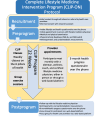Complete Lifestyle Medicine Intervention Program-Ontario: Implementation Protocol for a Rural Study
- PMID: 39740215
- PMCID: PMC11733517
- DOI: 10.2196/59179
Complete Lifestyle Medicine Intervention Program-Ontario: Implementation Protocol for a Rural Study
Abstract
Background: Sedentary lifestyles, poor nutritional choices, inadequate sleep, risky substance use, limited social connections, and high stress contribute to the growing prevalence of chronic diseases. Lifestyle medicine, emphasizing therapeutic lifestyle changes for prevention and treatment, has demonstrated effectiveness but remains underutilized in clinical settings. The Complete Lifestyle Medicine Intervention Program-Ontario (CLIP-ON) was developed to educate the rural population of Northern Ontario in lifestyle medicine to improve health outcomes and engagement.
Objective: This study evaluates the implementation and effectiveness of the CLIP-ON program for patients with chronic diseases in the Parry Sound area, focusing on lifestyle behaviors, health outcomes, enrollment, retention rates, and interdisciplinary team engagement.
Methods: This observational cohort study guided by the RE-AIM framework (Reach, Effectiveness, Adoption, Implementation, and Maintenance) includes pre- and postintervention assessments from participants and health care providers. A hybrid type II mixed methods design evaluates the intervention's effectiveness and implementation process in real-world settings through quantitative and qualitative data collection. CLIP-ON is tailored to the residents of the Parry Sound catchment area in Northern Ontario. Participants (≥18 years old) with chronic conditions such as prediabetes, type II diabetes, systemic hypertension, cardiovascular vascular disease, dyslipidemia, or high BMI (≥25) will be recruited through self-referral or provider referral. Approximately 10 participants per cohort will be enrolled in the CLIP-ON program, consisting of 22 weeks of weekly group sessions and monthly individual consultations with physicians, health coaches, kinesiologists, and registered dieticians either in person or through a web-based platform. CLIP-ON will cover the 6 pillars of lifestyle medicine through 14 group sessions followed by an 8-week supervised exercise program. Anthropometric and cardiometabolic variables will be measured before and after the program. Participants will be surveyed on lifestyle habits, wellness, perceived barriers, and program satisfaction at 3 and 6 months. Focus groups and dropout interviews with participants (n=10 per cohort) and providers (n=6 per cohort) will guide program adaptations. Quantitative and qualitative data collected at baseline and follow-up will assess the program's implementation and identify barriers and opportunities for improvement.
Results: This study was approved by the Laurentian University Research Ethics Board (6021397) on July 6, 2023. The first cohort was enrolled in late 2023 and is still under evaluation. The second cohort began in mid-2024, and data collection is currently underway. A mixed methods analysis will be used at enrollment, program completion (22 weeks), and follow-up (6 months after program completion). Focus groups assessing the program's effectiveness and implementation will take place after the 22-week intervention. Data will be analyzed in early 2025.
Conclusions: This protocol provides insights into the implementation of this lifestyle medicine program and its impact on participants' health. The findings will guide future advancements and establish a scalable model for other communities.
Trial registration: ClinicalTrials.gov NCT06192251; https://clinicaltrials.gov/study/NCT06192251.
International registered report identifier (irrid): DERR1-10.2196/59179.
Keywords: barriers; chronic disease; feasibility; holistic medicine; implementation; lifestyle medicine; nutrition, exercise; opportunities; relationships; risky substance use; rural medicine; self-compassion; sleep; stress reduction; substance use; web-based platform; wellness; whole health.
©Kush Patel, Lisa Allen, Karine Boucher, Michelle Fedele, Debbie Fong, Sangeeta Kumar, Deanna Lavigne, Elisa Marin-Couture, Magdalena Partyka-Sitnik, Nicole Rietze, Jenna Smith-Turchyn, Mylene Juneau, Caroline Rhéaume. Originally published in JMIR Research Protocols (https://www.researchprotocols.org), 31.12.2024.
Conflict of interest statement
Conflicts of Interest: JST holds research grant funding from the Canadian Institute for Health Research, the Social Science and Humanities Research Council of Canada, and the Canadian Cancer Society. She was paid from the grant associated with this project to run the focus groups. All other authors declare no conflict of interest.
Figures


Similar articles
-
Telehealth Diabetes Prevention Program for Adults With Prediabetes in an Academic Medical Center Setting: Protocol for a Hybrid Type III Trial.JMIR Res Protoc. 2023 Nov 13;12:e50183. doi: 10.2196/50183. JMIR Res Protoc. 2023. PMID: 37955955 Free PMC article.
-
Remote Lifestyle Intervention to Reduce Postpartum Weight Retention: Protocol for a Community-Engaged Hybrid Type I Effectiveness-Implementation Randomized Controlled Trial.JMIR Res Protoc. 2025 Jan 7;14:e62847. doi: 10.2196/62847. JMIR Res Protoc. 2025. PMID: 39773922 Free PMC article.
-
Effectiveness of the Pasifika Women's Diabetes Wellness Program (PWDWP): Protocol for a Pilot Intervention and Feasibility Randomized Controlled Trial.JMIR Res Protoc. 2024 Mar 11;13:e55435. doi: 10.2196/55435. JMIR Res Protoc. 2024. PMID: 38286130 Free PMC article.
-
Folic acid supplementation and malaria susceptibility and severity among people taking antifolate antimalarial drugs in endemic areas.Cochrane Database Syst Rev. 2022 Feb 1;2(2022):CD014217. doi: 10.1002/14651858.CD014217. Cochrane Database Syst Rev. 2022. PMID: 36321557 Free PMC article.
-
A review of whole-medical systems and holistic care approach for type 2 diabetes and associated metabolic syndrome.J Integr Med. 2024 May;22(3):199-209. doi: 10.1016/j.joim.2024.04.001. Epub 2024 Apr 10. J Integr Med. 2024. PMID: 38658284 Review.
References
-
- Public Health Ontario, CCO The Burden of Chronic Diseases in Ontario. 2019. [2024-11-13]. https://www.publichealthontario.ca/en/Data-and-Analysis/Chronic-Disease/... .
-
- GBD 2019 DiseasesInjuries Collaborators Global burden of 369 diseases and injuries in 204 countries and territories, 1990-2019: a systematic analysis for the Global Burden of Disease Study 2019. Lancet. 2020;396(10258):1204–1222. doi: 10.1016/S0140-6736(20)30925-9. https://linkinghub.elsevier.com/retrieve/pii/S0140-6736(20)30925-9 S0140-6736(20)30925-9 - DOI - PMC - PubMed
-
- World Health Organization (WHO) Non communicable diseases. [2024-07-02]. https://www.who.int/news-room/fact-sheets/detail/noncommunicable-diseases .
-
- Sagner M, McNeil A, Puska P, Auffray C, Price ND, Hood L, Lavie CJ, Han Z, Chen Z, Brahmachari SK, McEwen BS, Soares MB, Balling R, Epel E, Arena R. The P4 health spectrum - A predictive, preventive, personalized and participatory continuum for promoting healthspan. Prog Cardiovasc Dis. 2017;59(5):506–521. doi: 10.1016/j.pcad.2016.08.002.S0033-0620(16)30078-0 - DOI - PubMed
-
- Alexander S, Ostfeld RJ, Allen K, Williams KA. A plant-based diet and hypertension. J Geriatr Cardiol. 2017;14(5):327–330. doi: 10.11909/j.issn.1671-5411.2017.05.014. https://europepmc.org/abstract/MED/28630611 jgc-14-05-327 - DOI - PMC - PubMed
Publication types
MeSH terms
Associated data
LinkOut - more resources
Full Text Sources
Medical
Miscellaneous

